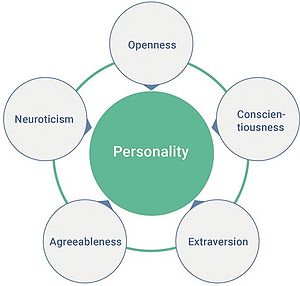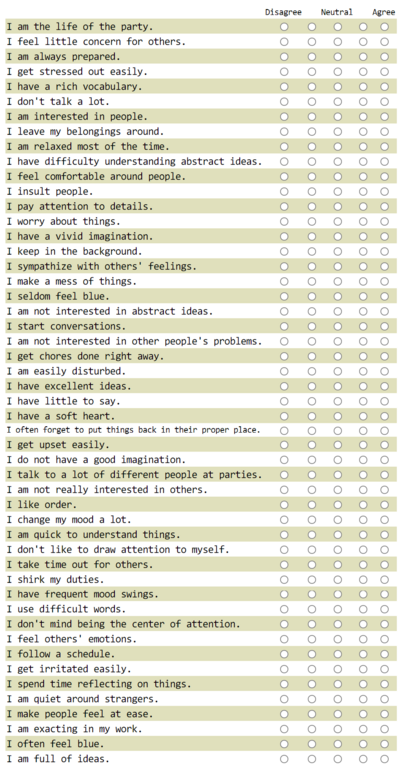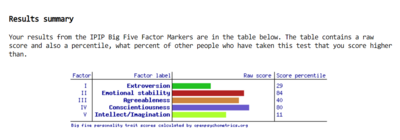The Big Five(OCEAN) Personality Traits
Qifan Wang (Talk | contribs) (→Application) |
Qifan Wang (Talk | contribs) (→Application) |
||
| Line 31: | Line 31: | ||
== Application == | == Application == | ||
| − | [[File:questionnaire.png| | + | [[File:questionnaire.png|400px|thumb|right|Figure 2: Questionnaire of personality test.]] |
| − | [[File:R1.png| | + | [[File:R1.png|400px|thumb|right|Figure 3: results of personality test.]] |
The big five OCEAN model test is widely considered to be the most scientifically robust way to describe people’s personality traits contemporarily. Generally, the test presents as a form of questionnaire and consists of 60 fixed questions that have been ensured valid and reliable. People who get tests should complete the questionnaire in 5-10 minutes. A brief report will be presented including scores of each perspective and giving results on what types of personality you are<ref name='test'/>. | The big five OCEAN model test is widely considered to be the most scientifically robust way to describe people’s personality traits contemporarily. Generally, the test presents as a form of questionnaire and consists of 60 fixed questions that have been ensured valid and reliable. People who get tests should complete the questionnaire in 5-10 minutes. A brief report will be presented including scores of each perspective and giving results on what types of personality you are<ref name='test'/>. | ||
Revision as of 23:30, 10 March 2022
Contents |
Abstract
Projects are done by people and for people.[1] Good project management is about how to organize people efficiently involving positions and tasks assigning, ways of communication, meeting people's satisfaction, etc.
Personality traits play an important role in people management, which have a big influence on success, efficiency, satisfaction, risk attitudes, performance, and more of projects. Since in a project, people have different backgrounds, interests, and personalities that make people think and manage the tasks in a different way and increase risks of conflicts somehow. A good perception of employees’ personality traits is a key for project managers to organize and design their teams. The similar and complementary personality traits make people, from different backgrounds and interests, well connected in a project and highly affect how and what they do in a project. Similarly, the action and decisions that project managers made are impacted by personality traits, which are not related to the technical part. It also influences how project managers deal with the relationship of different stakeholders.[1]
The so-called big five (OCEAN) personality traits theory is considered the dominant approach for representing the human trait structure today. Researchers have used the theory to predict individual differences in numerous settings: clinical (reviewed in Costa, 1991), industrial and organizational (e.g., Barrick & Mount, 1991, 1996; Barry & Stewart, 1997; Mount & Barrick, 1995), counseling (McCrae & Costa, 1991), and more [2].It was founded by Fiske (1949) and later expanded and elaborated by Norman (1967), Smith (1967), Goldberg (1981), and McCrae and Costa (1987). This theory contains five basic factors that are Openness, Conscientiousness, Extraversion, Agreeableness, Neuroticism[3].
The Big Idea
What is the big five(OCEAN)
The big five(OCEAN) theory has developed, widespread, and ascended to the dominant status of the personality researching field in the last 20 years[4]. Apparently, the acronym OCEAN, the capital five letters, come from five basically general-accepted perspectives of personality traits are Openness, Conscientiousness, Extraversion, Agreeableness, and Neuroticism.
Openness(O): It is also named as openness of experience. Individuals who score high on this dimension tend to be intellectual, imaginative, sensitive, and open-minded. Those who score low tend to be down-to-earth, insensitive, and conventional[2]. Research has shown that openness to experience is an important component of leadership effectiveness and seems particularly important at higher organizational levels. Leaders with higher openness to experience scores take a more strategic approach to solving problems, this can help those in higher leadership or management positions keep abreast of market trends, competitive threats, new products, and regulatory changes[5].
Conscientiousness(C): Individuals high in Conscientiousness tend to be careful, thorough, responsible, organized, and scrupulous. Those low on this dimension tend to be irresponsible, disorganized, and unscrupulous[2]. Conscientiousness is an aspect of ego and strength over time and is often associated with terms such as willpower, initiative, and responsibility[3].
Extraversion(E): Individuals who score high on Extraversion tend to be sociable, talkative, assertive, and active; while those who score low are more reserved in nature, but does not mean that they are socially hostile, instead are retiring, reserved, and cautious. Moreover, the active and assertive aspects of Extraversion facilitate the goal of achievement values, success through demonstrating competence according to social standards[2]. Leaders high in extraversion come across as self-confident, outspoken, opinionated, and competitive[3].
Agreeableness(A): Individuals who score high on Agreeableness tend to be soft-hearted, kind, good-natured, trustworthy, helpful, forgiving, and altruistic[3]. Individuals who score low on this dimension tend to be irritable, ruthless, suspicious, and inflexible[2]. Agreeableness, is primarily a dimension of interpersonal behaviors, whereas extraversion is more related to the preferred quantity of social excitability. Agreeableness represents more on the quality characteristics of the interaction. This dimension is most familiar in its role as one of the defining axes of interpersonal behavior. Agreeableness also influences the self-image of an individual and helps shape social attitudes and the principles of life itself[3].
Neuroticism(N): Neuroticism refers to the chronic level of how an individual adjusts their emotions and instability. Individuals who score high in neuroticism tend to be identified as those who are vulnerable to psychological distress. This includes a high pessimistic way of thinking, such as anger, hostility, depressiveness, anxiety, and volatility. However, neuroticism also involves the vulnerability of an individual towards stress, self-consciousness, extreme desire, urges, and the difficulty to handle frustration caused by not acting based on their will[3]. Differences in neuroticism can be somewhat difficult to observe in predictable, routine situations but become readily apparent during times of uncertainty or crisis. leaders who are calm under pressure and thick-skinned can often help a group stay on task and work through any difficult issues[5].
Who need it?
The big five (OCEAN) personality traits theory, regarding as a tool, are usually used in the human resources(HR) department of a company, especially for employers, project managers, and recruiters. Meanwhile, it can be also used by employees in the work environment [6].
For the HR department, a good employee is a key to success for projects. The project managers or recruiters can make full use of the OCEAN model to identify people whether they suit the position and the company culture or not. This is crucial in project management.
For employees, the big five(OCEAN) personality traits theory can boost employees’ career prospects or help them find a new role in the company. This could happen before or after employees get offers. In a word, this tool can definitely instruct people in their careers.
Nevertheless, the big five (OCEAN) personality traits are applied in academia far and wide. Researchers apply the OCEAN model in different fields and attempt to find out the relationship between personality and behavior.
Application
The big five OCEAN model test is widely considered to be the most scientifically robust way to describe people’s personality traits contemporarily. Generally, the test presents as a form of questionnaire and consists of 60 fixed questions that have been ensured valid and reliable. People who get tests should complete the questionnaire in 5-10 minutes. A brief report will be presented including scores of each perspective and giving results on what types of personality you are[7].
Application in career
As mentioned above, in the industrial area, recruiters and project managers can use the tool to judge people’s personalities as a basic selection criterion. First of all, recruiters and project managers should have a clear understanding of the cultures and natures of their company and certain projects. This is related to what kind of people they determine to hire and use. For instance, if the company culture is relaxed, recruiters may need some people with high extraversion and agreeableness scores. Inversely, recruiters need people with low scores of extraversion and high scores of conscientiousness if the company culture is bureaucratic and structured. Similarly, project managers need people with high scores of conscientiousness in projects that are filled with routine work and structured processes as well as those with high scores of openness and agreeableness if collaboration and creativity are necessary for projects[6].
It is also important that personality traits have an ignorable influence on the personal career. Once people have a clear cognition of their personality, they can judge whether the position where they are staying and jobs that they are working currently are suitable for them or not. For instance, if people have a low score in extraversion, they are probably feeling nervous and stressed and are not likely to be successful in a crowded workplace since, in that kind of place, people have to need much more social skills to contact others and cannot focus on work. Conversely, those introverted people are more suitable for quiet places where they can concentrate on their research.
Another example is that those who have a high level of neuroticism are not the right fit for the job with extreme pressure and meeting deadlines or demanding targets the whole time. When people recognize this point, it is a good time for them to find a new role in their current company or organization or even submit a resignation for good.
In one word, people who have a full understanding of the big five OCEAN models can much easier pursue the most suitable role or career for themselves[6].
Application in research
In addition, as mentioned above, the big five (OCEAN) is the basis of most modern personality research. Therefore, a large number of research results are obtained from the big five (OCEAN) model.
Chia Kuang Lee and Mei Yit Foo (2020) supposed that risk attitude is influenced significantly in a positive manner through an individual’s openness to experience and extraversion while reacting negatively towards neuroticism[3].
Miranda A. G. Peeters et al.(2006) think that team members’ satisfaction with their team increases if he or she is more agreeable and emotionally stable, is more similarly conscientious, and is similar and less extravert[8].
Sonia Roccas et al.(2016) found the relationship between the big five personality traits and personal values[2].
Rothmann S and Coetzer E PA(2003) found a combination of emotional stability (i.e. low Neuroticism), Extraversion, Openness to Experience, and Conscientiousness explained about 15% of the variance in task performance and creativity[9].
M. A. Moore and J. F. Vucetic(2014) pointed out that agreeableness positively affects the project success factor of time and neuroticism has a strongly negative influence on all aspects of a team and basic project measures and planned to apply this conclusion in the IT project management community in team member selection[10].
Criticisms and Limitations
The big five (OCEAN) personality traits theory has been invented and applied for more than 70 years, which almost became a ‘common sense' in people’s life. Nevertheless, there is a large number of arguments in the academic world.
McAdams criticized that the big five (OCEAN) theory cannot explain the ‘whole person', and it is weak on causal explanations for personality. Once researchers determined these five factors, we can only look at those five factors. There have been critics pointing out that these five factors are only functional to control people’s behaviors incompletely. Even someone has the idea that the so-called ‘traits’ do not exist in the world and researchers just generated the term to describe and explain people’s behaviors in this way and it works occasionally well-functioned[4].
Leaving the philosophical assumption alone, the big five (OCEAN) personality traits theory has limitations[11]:
- is bound by its method of discovery,
- is missing many personality traits shown to be important in work settings (or may be important in the future),
- might obscure rather than highlight relationships with criterion constructs,
- consists of factors with relatively low construct validity (i.e., the distinctiveness of the facets), and
- is useful but in some important ways will hinder our progress in modeling personality-based determinants of work-related behaviors and outcomes.
Leaetta M. Hough et al. (2015) listed some missing personalities and defined them in many clusters.
- Honesty (fairness, honesty/humility, machiavellian, manipulative, cunning, sly, deceptive, villainy)
- Interpersonal (consideration, folksiness, need to be supportive, prejudice, psychopathy, social insight/social adroitness, reciprocal altruism, sensuality/seductiveness, social independence),
- Intrapersonal(absorption, ease in decision making, ego resiliency/self-regulation, egotism/snobbery/conceit, emotionality, heroism/prowess, mental illness(clinical assessment), narcissism, need for rules and supervision, sensation-seeking/impulsivity/risk-taking, tolerance for contradiction, uncertainty orientation)
- Values(conservatism/value orthodoxy, conventionality, frugality/thriftiness, religiosity/devoutness)
- Self-evaluation(negative valence, positive valence)
- Interests(artistic, conventional, enterprising, investigative, realistic, social)
- Other(fashionableness, humorousness, masculinity/femininity/rugged individualism, work pace)
Other alternative personality models[11]
- HEXACO Model
The model consists of six factors: honesty-humility (H), emotionality (E), extraversion (X),11 agreeableness (A), conscientiousness (C), and openness to experience(O). Its origins are from lexical research and factor analysis. Although HEXACO models use six factors to describe a person's personality traits that are similar to the big five (OCEAN) theory, it does not merely add one more factor than the big five (OCEAN) model. Since it has a more elaborate description of some dimensions (e.g. in emotionality, HEXACO models contain sentimentality, vulnerability, fearfulness, anxiety, and emotional dependence to characterized while the big five (OCEAN) model only use two factors: neuroticism and agreeableness.) Secondly, the HEXACO model is more compressive, which means it can cover more personality traits. Nonetheless, the HEXACO model needs more data and research to prove its validity and still lacks many personality variables.
- Circumplex Models
In order to solve the issue from the hierarchical models(e.g. the big five (OCEAN) and the HEXACO model) as personality traits tend to correlate with each other. Therefore, the circumplex model was created and it can better explain the relationships between personality traits. In this model, the relationships between personality traits are envisioned as a circle, which better reflects the correlation of each factor and allows facets to correlate with all other factors when such correlations exist. Nevertheless, circumplex models are two-dimensional and might consider only two factors at a time, which can limit the way the facets are considered.
- Nomological-Web Clustering Approach
This is an open network that allows it to revise and redefined the criteria continuously with the increase of knowledge. the main goal of this method is to explore the depth of personality traits instead of the breadth that researchers did in the past. Since, recent research has indicate that the personality traits do not independently tend to hierarchical.
Annotated bibliography
- ↑ 1.0 1.1 Geraldi, Joana et al. How to DO Projects : A Nordic Flavour to Managing Projects. Dansk Standard, 2017, pp. 160 s.
- ↑ 2.0 2.1 2.2 2.3 2.4 2.5 Roccas, Sonia, et al. “The Big Five Personality Factors and Personal Values.” Personality and Social Psychology Bulletin, vol. 28, no. 6, Sage Publications, 2002, pp. 789–801, doi:10.1177/0146167202289008.
- ↑ 3.0 3.1 3.2 3.3 3.4 3.5 3.6 Lee, Chia Kuang, and Mei Yit Foo. “Risk Attitudes and the Big Five Personality Traits: a Study on Construction Project Practitioners in Malaysia.” International Journal of Construction Management, Taylor and Francis Ltd., 2020, pp. 1–11, doi:10.1080/15623599.2020.1793506.
- ↑ 4.0 4.1 M. Hastings, Brad, and Mount Aloysius College. ROY G. BIV and the OCEAN A Heuristic Metaphor for Understanding the Role of the Five-Factor Model in Personality Research. 2016.
- ↑ 5.0 5.1 NIGEL CHETTY (MBA). The OCEAN Model of Personality[1]
- ↑ 6.0 6.1 6.2 Anastasia Belyh. The Big Five Personality Traits Model (OCEAN Model)[2]
- ↑ THE BIG FIVE PERSONALITY TEST [3]
- ↑ Peeters MAG, Rutte CG, van Tuijl HFJM, Reymen IMMJ. The Big Five Personality Traits and Individual Satisfaction With the Team. Small Group Research. 2006;37(2):187-211. doi: [10.1177/1046496405285458]
- ↑ Rothmann S, Coetzer E P. The big five personality dimensions and job performance[J]. SA Journal of industrial psychology, 2003, 29(1): 68-74. doi: 10.10520/EJC88938
- ↑ M. A. Moore and J. F. Vucetic, "Identifying Effective IT Project Manager Personality Characteristics," 2014 Annual Global Online Conference on Information and Computer Technology, 2014, pp. 96-100, doi: 10.1109/GOCICT.2014.28.
- ↑ 11.0 11.1 Hough L M, Oswald F L, Ock J. Beyond the Big Five: New directions for personality research and practice in organizations[J]. Annu. Rev. Organ. Psychol. Organ. Behav., 2015, 2(1): 183-209.


